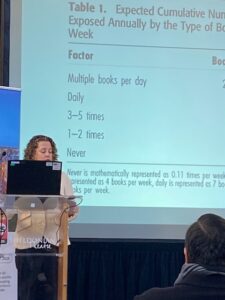Dr Molly Ness at World Literacy Summit: Obstacles to Children’s Reading Development

Attending the World Literacy Summit was an educator’s dream and I can’t wait to share our findings with teachers and parents alike. Each week we will share research, ideas from some of the best in the business and things that you can do today to boost every child’s reading ability!
I had a 4th row seat to listen to Dr Molly Ness’ keynote speech: When There are no Bedtime Stories: Obstacles to Children’s Literacy Development. She was wonderful!
Learn from Dr. Molly Ness, a literacy expert, author, and podcast host, how to effectively inspire a passion for reading through the power of interactive read-alouds.
In today’s hyperfocus on the science of reading, we cannot overlook the essentiality of read-alouds in building students’ language comprehension. With an extensive research basis highlighting their cognitive, socioemotional, linguistic, and even physiological benefits, read-alouds are a key element in building students’ language comprehension. Though read-alouds may be a cornerstone of literacy instruction in early childhood classrooms, their frequency declines in both older grades and content area classrooms (DeJulio et al., 2022; Scholastic, 2017; Smith et al., 2022). Despite the well-documented benefits of read-alouds, a recent survey of elementary teachers revealed that 50–70% of respondents didn’t allot intentional planning time for their read-alouds (McCaffrey & Hisrich, 2017). Research indicates that when teachers do not intentionally plan their read-aloud discussions, they are more likely to ask surface-level questions, clarify content, or ask for simple summarizations, rather than facilitating richer text reflections or reactions (Haaland et. al, 2020).
What is an Interactive Read-Aloud?
An interactive read-aloud is a shared literacy experience engaging children and adults in conversation and engagement around a high-quality text. Read-alouds foster students’ higher-order thinking skills (Lennox, 2013), strengthen students’ independent writing (Dowdall, Melendez-Torres, Murray, Gardner, Hartford, & Cooper, 2020), increase the likelihood to engage in independent reading (Ledger & Merga, 2018), and develop students’ content knowledge and vocabulary (Dwyer & Martin-Chang, 2023). Read-alouds are particularly beneficial for multilingual learners, with increases in vocabulary and comprehension (see Giroir, Grimaldo, Vaugh, & Roberts, 2015; Schrodt, Fain, & Hasty, 2015). Read-alouds foster socio-emotional development, including helping students control emotional outbursts and improving their ability to empathize (Thompson & Melchion, 2020; Verden, 2012). Lastly, read-alouds evoke joy, for both students and teachers (Ledger & Merga, 2018).
Maximizing the Potential of Read-Alouds
The following pointers help to unpack the instructional richness of read-alouds:
1) Select sophisticated text. Consider a 1984 meta-analysis conducted by Thomas Sticht; children’s listening comprehension surpasses reading comprehension until approximately age 13. In other words, when we read aloud, students can understand content that is far more sophisticated than that which they can decode independently. Additionally, children’s books are lexical reservoirs; a 2019 study shows that reading one picture book a day provides young children with 78,000 words a year (Logan et. al, 2019). Knowing that children can understand orally delivered texts that far exceed their grade level and the linguistic richness to which they are exposed should remind us to select complex texts to read aloud.
2) Frontload background knowledge: Prior to reading, consider the background knowledge that the text assumes the reader brings. If readers need some familiarity with a concept or topic in the text, think through how to intentionally frontload their knowledge to eliminate a potential comprehension stumbling point. Consider these reflective questions to identify background knowledge:
- What do students need to know about the topic before reading this book?
- Are there locations, references, interactions, events, or experiences in the book that students are likely to be unfamiliar with?
- What does the book assume readers bring to the page with them?
- Are there elements of a character’s background, culture, or community that might be unfamiliar to readers?
3) Think aloud while reading: Embrace the instructional opportunities of think-alouds – the purposeful use of “I language” to model how you are making meaning from the text (Ness, 2018). Through first person narrative language, use these think-alouds to show how you are making inferences, synthesizing information, generating questions about the text, considering the author’s purpose, and addressing the times that you address comprehension breakdowns. The list below are some sentence starters to jumpstart think-alouds:
- I’m getting the sense that….

- I’m wondering….
- I’m not sure I understand when/how….
- At first I thought….., now I think…..
- I’m confused here, so I might…..
- I’d like to ask the author….
Prioritizing Read-Alouds in Your Instruction
Once we embrace the read-aloud as an opportunity to build engagement, vocabulary, content knowledge, comprehension, motivation, and so many other academic skills, we increase students’ development as readers, writers, and thinkers. Explicit planning of the read-alouds offer these opportunities every day, in every classroom. As we thoughtfully align our instruction with the science of reading, we must be mindful that read-alouds are not an instructional luxury, nor a time filler. The read-aloud is a must do, want to do, should do, get to do, have to do, and essential in building students’ language comprehension across elementary and secondary classrooms.
Literacy for Boys and Literacy for Kids recognizes the many benefits of reading aloud to engage our learners and build their vocabulary – it’s why our programs are a great literacy tool. Our resources and programs are not only saving teachers’ time but helping kids all over Australia learn to improve their literacy skills!
Check out our blogs for more ideas and tips.
4 Signs that Readers are Frustrated and Offered Solutions
Helping Boys Find their own Masculinity
4 Common Misunderstandings about Comprehension
Boys Love LFB – Here’s what they have to say!
Get boys reading in the digital age
Why write? Tips for reluctant writers
Brought to you by Tanya Grambower
